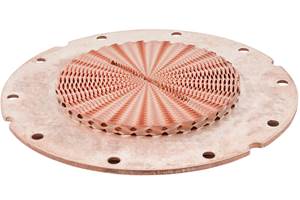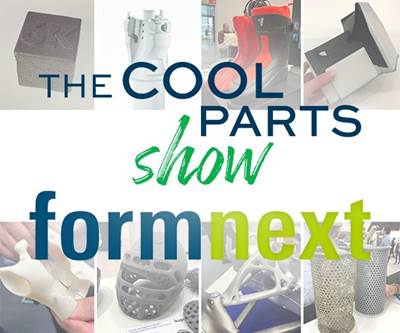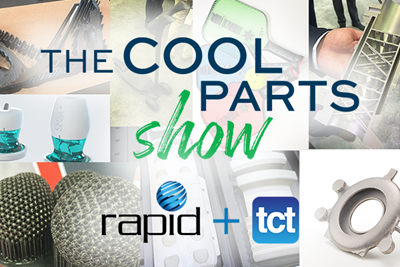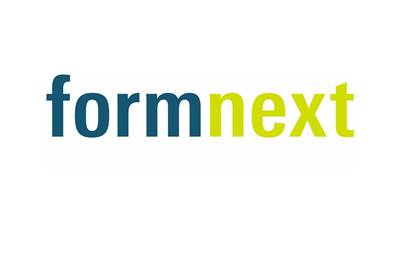8 Cool Parts From Formnext 2021: The Cool Parts Show #36
The world’s leading trade show for industrial 3D printing returned as an in-person event. Among all the additive manufacturing technology showcased at the show, we also found our most amazing batch of cool parts so far.
Share
Formnext returned! The world’s leading trade show for additive manufacturing was not held in-person last year due to the pandemic, but this year it was back to being a bustling, expansive four-day showcase for the latest in industrial 3D printing technology. Cohost Stephanie Hendrixson and I traveled to Frankfurt, Germany, to attend the show, and here is just some of what we found: eight of the coolest parts from Formnext 2021. | This episode of The Cool Parts Show brought to you by Carpenter Additive
The Cool Parts Show is a video series from Additive Manufacturing Media that explores the what, how and why of unusual 3D printed parts. Watch more here.
Have a cool part to share? Email us.
Related resources
- Formnext
- Aconity3D and Equispheres’ pursuit of faster print speeds
- Wayland Additive’s electron powder bed fusion system
- Exergy Solutions’ use of Vibenite metal
- Replique platform for on-demand replacement parts
- Carbon’s Design Engine lattice software
- Specialized bike saddle with variable support
- Meltio’s wire or powder directed energy deposition technology
- Alloyed’s union of metal engineering and AM
- Nobula and 3D printing of glass
- Sand speaker from Deeptime Audio
- Our earlier episode on 3D printed speakers
- The big news from Germany: Formnext USA is coming!
- More to come on Formnext 2021! Subscribe to our podcast, AM Radio
Transcript
Peter Zelinski
I'm Pete.
Stephanie Hendrixson
I'm Stephanie.
Peter Zelinski
Welcome to The Cool Parts Show.
Stephanie Hendrixson
This is a special episode of The Cool Parts Show all about cool things that we saw at Formnext 2021.
Peter Zelinski
Formnext, biggest show we know of devoted to additive manufacturing, tradeshow in Frankfurt, Germany. It was in person again, back to being a real regular show. We were excited to be there! Saw lots of cool stuff.
Stephanie Hendrixson
So starting back in 2019, we've been doing these special episodes where we highlight eight cool parts from the trade shows that we've been to, and we're gonna do it again. Alright, so our first cool part is an example of 3D printing, helping 3D printing. This is a component within the Aconity scan system. It's part of the Aconity 3D laser powder bed fusion platform, and it was made on that very same platform. So this part is interesting for a couple of reasons. First, the printer that it goes into is really special and unique. Aconity does completely modular 3D printers. So you can choose from all different accessories and configurations, they have something like 3000 different combinations that you can create using their online printer builder. This component is also interesting though for the material that it was made out of. So this is 3d printed from an aluminum alloy powder produced by equispheres. Equispheres has developed this process where they get really spherical, very uniform metal powders. And that has a lot of benefits in terms of the flowability, the spreadability and it can lead to denser, better parts. They can also be 3d printed faster. So previously, Aconity was making this part through laser powder bed fusion with a different aluminum powder, and it took something like 53 hours to print each one. Just by switching to the equispheres powder, they can now print each one of these in about 17 and a half hours. At the show, they were also using this as an example of how manipulating the layer height can have effects on the print time as well as the surface finish. So here are two different versions of this part. The smoother one that you see there is the production part, the 17 and a half hour print. But if you wanted to speed that up and you didn't care so much about the surface finish, you could print it in four hours and get the other result that you see there.
Peter Zelinski
All right here is a 3D printed gear hob, a tool for cutting the teeth in gears. This was made by Exergy Solutions of Canada in Vibenite material from VBN Components. Super hard steel alloy, like 70 Rockwell C if you're familiar with hardness measurements. And the harder material makes for a more effective tool for making gears. But the thing is, that very hardness of the material makes the material hard to work with. Additive manufacturing offers real promise here. So this gear hob was made through electron beam powder bed fusion. Electron beam additive manufacturing, vital for working with this very hard material without stress cracking. This was made on the Calibur3 electron beam system from Wayland Additive. And part of what's so significant about this part is just a new entrant to electron beam additive manufacturing. Different platform, different technology provider offering solutions in this space. More options for electron beam additive manufacturing promises to bring expanded opportunities for working with really really hard metals.
Stephanie Hendrixson
Our next part is actually a replacement part. This is an adjustment bracket for a lounge chair. The chair is sold by Sienna Garden, which I learned is one of the most popular outdoor furniture brands in Germany and the original component would have been injection molded, but this one was 3D printed using selective laser sintering. So, this is an example of a part that is available on the Replique digital inventory platform. Replique is this project that was started as an incubator within BASF, the materials company, and they're getting ready to spin out into their own business pretty soon here. But basically, the idea is that it's a digital inventory platform. So Replique works with OEMs, like Sienna Garden, to digitize their parts, to protect their files, and then they have a network of 40 some different suppliers around the world so that when a customer needs something, they can activate this network have the parts made nearby and on demand as soon as it's needed. So this is sort of an example of what they're calling the eternal spare part. A case where it doesn't matter whether the original part or product is still actively in production, or whether there is still inventory in a warehouse somewhere, you can always get the part that you need thanks to this digital platform. And as we talk more and more about these things like sustainability and right to repair laws, this can be a really great solution. So this is an example where the original part that was injection molded maybe only cost one or two euro, the 3D printed component might cost eight to 10 euros. But if that is the difference between throwing away your 300 euro chair, or keeping it, repairing it and continuing to use it, that could be a really big difference.
Peter Zelinski
All right here is a bike saddle. This is from bike equipment maker Specialized working with polymer manufacturer, Erschler and Carbon which offers 3D printing technology through digital light processing. So this bike saddle gets different softness and stiffness in different areas of the saddle, thanks to differences in the lattice design. Now conventional padding on a bike saddle, it's either soft or it's not right, it's either padded or it's not. But 3d printed lattices offer the ability to fine tune exactly the responsiveness, exactly the give or stiffness in every different area of the saddle, get exactly the seating and experience that the bike rider needs. So you can see the changes in the lattice structures here getting those those different levels of give of stiffness. The cell size of the of the lattices varies, the strut thickness varies. And all of this was done using software from Carbon that Carbon has now made publicly available and called Design Engine, a software tool specifically for working with lattices. Carbon realized a big part of the promise of 3D printing in various ways relates to lattices. But to date, there's been no really good software tool, no really good design tool focused on lattices. Design Engine, it doesn't just output geometry for Carbon system, it could be used with any 3d printer could even be used with a metal 3D printer. And it allows not just fine tuning of strut thickness and cell size, but also the selection among different types of lattices, all of which behave differently. The user looks for exactly the stress strain relationship that they're looking for in each different area of the part and selects, manipulates the lattices accordingly. So this is now mastering a design possibility that only makes sense in 3D printing.
Stephanie Hendrixson
Alright, so our next part is a nozzle for filling bags of concrete. So this is how you would get your dry concrete powder into packaging for shipping and for sale. This nozzle was 3D printed using technology from Meltio, this is a Spanish company that provides directed energy deposition, DED solutions. They have a standalone printer as well as engines that can be attached to a robot arm or put into a CNC machine tool for hybrid manufacturing. And this particular component, I will say is maybe not the weirdest or strangest thing that they had in their booth, like they can do all this crazy multi material printing, they can print with both wire and powder. But this is a really interesting real customer use case, for a couple of reasons. So the original component was being machined, which as you can imagine, would mean taking a lot of material out. You're losing a lot of material, it takes a long time, and the component was costing something like 1,000 Euro. So it was a very expensive part. By switching to a DED process, they were able to take that cost down to just a fraction. This component costs 31 Euro. So a really really huge cost savings, as well as a time saving. So you no longer have to wait for tooling, you can print this in about six and a half hours. But the thing I thought was so interesting about this part is that previously, the client was accustomed to a smooth surface finish because this was being machined. But it turns out that actually the surface finish isn't all that important for this nozzle, it doesn't need to be that smooth, you can actually use it almost directly off the printer. So what you see here only requires very minimal post processing before it can go into use. And I thought it was just a really interesting case of how our assumptions around how things should look and how things should feel, maybe have more to do with the way that they have conventionally been manufactured than they do with the actual functionality.
Peter Zelinski
This is a cooling plate for data centers. Our digital world uses a lot of power. Look this up, data centers currently consume something like 1% of the world's total energy output and that percentage is rising. [Note from Pete: It would have been more precise to say “1% of the world’s total electricity output.”] So the chance to do data centers in a more energy efficient way is potentially tremendously impactful. So this cooling plate design, it comes from Alloyed which is the union of a materials engineering company Oxmet, and an additive manufacturing specialist Betatype. And both of those, both of those areas of expertise are flowing into this part. This cooling plate, its effectiveness, its energy efficiency, its effectiveness at heat transfer comes from not just the geometry, that's important the 3D printed geometry, but also the material it's made of, copper. A metal that's very effective at heat transfer, but also a metal that's very difficult to work with in 3D printing. Getting it to print effectively in this form requires significant materials expertise. But what this part illustrates is how additive manufacturing it is not just a geometric possibility, but also a materials application possibility. And as those two design freedoms start to come together more and more, they are pushing out into solutions in areas we haven't even thought of yet.
Stephanie Hendrixson
Alright, for this next part, I'm going to tell you two words and then I will explain. Two words, bird backpack. So I was walking by the Formnext startup area, and I saw this sign about 3D printed glass. So I stopped and I started talking to this startup called Nobula. They're a Swedish company, they were one of the winners of the Formnext Startup Challenge this year. And they have developed a process for 3D printing with glass. So it's sort of an extrusion process where they're laying down glass, they have lasers on either side that melt it just enough to fuse the layers together. They had to invent the printer, they also had to invent the feedstock. And so 3D printing with glass has all of these potential applications in micro fluidics, in pharmaceuticals manufacturing, and yes, of course, bird backpacks. So, the company learned about some researchers that were trying to study the Arctic Tern. So this is a bird that has maybe the largest migratory range of any species. It travels from the Arctic Circle to the Antarctic every year. And we haven't had a great way to study that migratory pattern so far. And so they needed a way to enclose and attach sensors to the backs of these birds as they're traveling. So the enclosure had to be really really lightweight, it couldn't weigh more than half a gram. It had to be watertight, because these birds dive into the sea to get fish to eat, so it was going to be exposed to saltwater. It had to withstand extreme temperatures and previous enclosures that they had had made out of plastic actually started to degrade because of UV exposure. So they thought that maybe glass would be the solution. And Nobula was able to 3D print these enclosures, they actually weigh just point three grams, so they came in under their weight limit. And this might allow us to learn a lot more about these birds that we've had difficulty studying in the past.
Peter Zelinski
Okay, one more cool part at Formnext. These are audio speakers and a subwoofer, 3D printed. We've done an episode of The Cool Parts Show on 3D printed speakers because the 3D printed geometry allows sound engineers to get a form that is just perfectly suited to the acoustics of the equipment, but you need to match that form to just the right material. So these speakers are from audio equipment maker Deeptime Audio in Czechia, and they were having not the best luck working with the polymers that they were trying to 3d print their speaker's geometry in. The alternative they found is kind of a freaky material, sand. These speakers are made from infiltrated sand 3d printed in this material and for Deeptime, they discovered that the sand actually offered an acoustically effective, cost effective, heavy material for making these speakers out of. They were 3D printed through binder jetting on a system from ExOne. Sand 3D printing actually has been around a while but it's been used in the foundry industry, it's been used for making tooling for casting. Now various manufacturers here and there, one by one are discovering other part making possibilities for infiltrated sand. Deeptime is an example. In ExOne's booth at Formnext they were also showing a basin from a sink maker, a basin that was also made from 3D printed infiltrated sand.
Stephanie Hendrixson
Alright, that's a wrap on cool parts from Formnext 2021, but this is actually just the beginning of our coverage of the show. So next week, we will have an article coming out about different trends that we observe. You can find that in our AM Update newsletter which comes out on Wednesdays. Make sure you're subscribed to that and you'll get that right to your inbox. And then the following week, we are going to be publishing an episode of our podcast, AM Radio, again all about the show. So you can find links to subscribe and access all of that in the description below.
Peter Zelinski
This episode is brought to you by Carpenter Additive, we are at the company's powder production facility in Athens, Alabama, and we are standing on top of an atomizer. The Z1 is Carpenter Technology's largest vacuum atomizer, and it is the heart of the process for making additive manufacturing metal powder here at Carpenter Additive.
Stephanie Hendrixson
This facility is capable of producing up to 18,000 pounds of metal powder per day, plant manager Jordan Ralph talked us through the process.
Jordan Ralph
So an atomizer is a piece of equipment that is capable of melting and pouring molten metal into the stream of high pressure gas that turns that molten metal into tiny, tiny droplets that ultimately cool and form our powder, which looks like grey dust. So to start our process and the ultimate end to end solution that we have here we bring in raw materials, all the way down to individual elements, so nickel, cobalt, chrome, moly, niobium, we bring all of those raw materials into the shop. We utilize those materials to build charges that go into the atomizer. As you walk that flow path, you run through our charge makeup area where all of the materials are weighed out in very exact quantities. That ensures that we're able to hit our customer specifications, and hold the tight tolerances that we're looking for on a chemistry perspective. From there, the material is flown to the top of the atomizer and charged into the furnace. As the material is produced, it's poured out and is collected at the bottom of the atomizer. The material is then taken and transferred into a bulk container for processing through the rest of the value stream. The next stop for any of our atomized powder would be the screener. So that will remove the course portion of the powder. From there, we take it through air classification that takes the fine portion of the particle size distribution out and makes the final cut for an additive material like a 10 to 45. From there, we stack up all of those individual lots and put them into the 12,000 pound blender to make the single homogenous blends. At that point we are able to pack in any configuration that the customer is looking for whether that be drums, bottles, PowderTrace hoppers, we've got a lot of options to meet customer's needs. The atomization capability and all of the powder capabilities gives us a unique position where we're actually able to produce the powder, run testing through additive machines all the way through HIP and heat treat, do final testing on those products and then make additional changes or try to optimize things like our chemistry or sizing so that we ultimately can serve our customers better.
Related Content
With Electrochemical Additive Manufacturing (ECAM), Cooling Technology Is Advancing by Degrees
San Diego-based Fabric8Labs is applying electroplating chemistries and DLP-style machines to 3D print cold plates for the semiconductor industry in pure copper. These complex geometries combined with the rise of liquid cooling systems promise significant improvements for thermal management.
Read MoreAt General Atomics, Do Unmanned Aerial Systems Reveal the Future of Aircraft Manufacturing?
The maker of the Predator and SkyGuardian remote aircraft can implement additive manufacturing more rapidly and widely than the makers of other types of planes. The role of 3D printing in current and future UAS components hints at how far AM can go to save cost and time in aircraft production and design.
Read MoreTwo 12-Laser AM Machines at Collins Aerospace: Here Is How They Are Being Used
With this additive manufacturing capacity, one room of the Collins Iowa facility performs the work previously requiring a supply chain. Production yield will nearly double, and lead times will be more than 80% shorter.
Read More3D Printed Titanium Replaces Aluminum for Unmanned Aircraft Wing Splice: The Cool Parts Show #72
Rapid Plasma Deposition produces the near-net-shape preform for a newly designed wing splice for remotely piloted aircraft from General Atomics. The Cool Parts Show visits Norsk Titanium, where this part is made.
Read MoreRead Next
8 Cool Parts from Formnext 2019: The Cool Parts Show #6
Editors Peter Zelinski and Stephanie Hendrixson attended Formnext 2019 in Frankfurt, Germany. Here are 8 cool 3D printed parts spotted on the show floor.
Read More8 Cool Parts From RAPID+TCT 2021: The Cool Parts Show #32
North America’s largest AM trade show resumed! Here are some of the coolest cool parts we found.
Read MoreLeading Trade and Media Organizations Unite to Launch Formnext USA
Mesago Messe Frankfurt (the organizers of Formnext) and Messe Frankfurt USA announce a strategic partnership with AMT – The Association For Manufacturing Technology and Gardner Business Media to create a new show in the U.S. dedicated to all aspects of industrial additive manufacturing.
Read More















